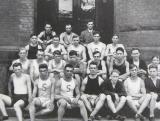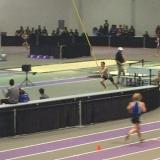Folders |
Track History - Original 'Fastest Human' Howard DrewPublished by
Howard P. Drew - The Original “World’s Fastest Human”
About 15 minutes south of his hometown of Springfield, Massachusetts and 10 minutes north of Hartford, Connecticut, where he worked and raised his family, is a small, nondescript veterans’ cemetery. In among the rows of plain white headstones is the final resting place and the only monument to Howard P. Drew, the original “World’s Fastest Human.” Howard Drew’s accomplishments as a student and athlete in the early years of his life were extraordinary, especially for a young, black man. His achievements as an author, coach, soldier, lawyer and judge were equally uncommon. He constantly made headlines, set numerous world records on the track, blazed trails in multiple sports, excelled in scholarship and in his career but now lays in near obscurity, all but forgotten by time. Drew was born in 1890 In Lexington, Virginia. His parents didn’t want to raise their son in the Jim Crow South so they re-settled in Springfield, Massachusetts. In the summer of 1905, when Drew was 15, he decided to sneak off to the Forth of July “Springfield City Games” to compete in the annual track and field competition. Not having any money to properly outfit himself, he sewed his own track uniform from one of his mother’s “borrowed” bed sheets and made his own spikes by driving roofing nails through the soles of his tennis shoes. He won the 100 yard dash but the nails hurt his feet so much he decided to run the 440 yard dash in bare feet - on a cinder track - and took first place as well. Drew later recalled "what the nails failed to do to my feet, the cinders on the ground did. I felt I had been walking on a sea of glass mingled with fire. I went home with sore feet but very proud of my two medals." It should be noted that he also won the Long Jump but tore out the stitching in his shorts in the process and had to make a hasty retreat. Howard Drew entered Springfield High School, as one of only very few black students, in 1906 but dropped out his freshman year to help support his family working as a bellhop. Not to be denied an education, he reentered high school in 1910 at the age of 20. He played baseball, was a star running back on the football team and was already acknowledged as one of the nations fastest sprinters. The head of the National AAU, Jack Sullivan, so impressed by Drew running a 10 flat 100y dash, he personally encouraged him to try out for the upcoming 1912 Stockholm Olympics. The road to the Olympic trials started in Harvard stadium where Drew won the 100 in 10 3/4 seconds. With financial donations spurred on by publicity in the Springfield newspapers, Drew headed to the University of Michigan for the US Trials. Howard Drew not only beat the fastest American of the time, Ralph Craig, he tied the World Record in the 100y dash. With financial aid coming from all over the state, including support from the mayor of Boston, Drew was joined on board the S.S. Finland by fellow track team member Jim Thorpe as they set sail for Sweden. Howard Drew had his fair share of injuries during his track career, including a time when partial paralysis threatened to end his running altogether. But none were so poorly timed as pulling a muscle in the semifinals of the 100 in Stockholm. Drew had easily won his prelim, practically jogging in at 11 flat. He decided to go for a record in the semi but at about the halfway mark, with a big lead, his left leg gave out. He hopped across the finish line in first place and was intent on competing in the finals but no amount of therapy could get him ready in time. His trainers told him he risked permanent injury, so with great disappointment he watched teammate Ralph Craig win both the 100 and 200 knowing he would have easily won had he been able to compete. Ralph Craig was recently inducted into the USA Track & Field Hall of Fame, primarily as a result of winning the gold at the 1912 Olympics. Drew did have an opportunity to play on the USA (exhibition) baseball team, sharing left fieldresponsibilities with Jim Thorpe. He was given an honorary medal and diploma by the US Olympic Committee, but not the 100 Gold Medal he anticipated on bringing home. Fate stepped in one more time to deny Howard Drew his chance for Olympic glory. The 1916 Olympics were cancelled due to World War 1. Drew was the star of the “Pershing Olympics” held in France for the Allied Forces but by the time tryouts for the USA track team for the 1920 Olympics came, Drew, now in his thirties, was unable to make the team. During his college days at USC between 1913-1916 Drew tied or set every World Record from 30 to 250 yards. The press called him the “Negro Speed Marvel,” the “Colored Flyer,” the “Negro Dash Man,” and the “Crack Colored Sprinter” but the title that was first given to anyone, still used to this day was “Fastest Man in the World.” Drew was a straight “A” student at USC, a member of the Skull and Dagger Honor Society, and a frequent contributing journalist to local newspapers. He continued his post-graduate education at Drake University where he continued to compete in track meets, played football and was a motivational speaker. He interrupted his education to enlist in the Army during World War I and was Honorably Discharged in 1919 as a Supply Sergeant. While in the Army he received a Victory Medal and one defensive bar for his service. In 1920 he passed the bar in Connecticut and moved to Hartford to set up a law practice (one of only four black attorneys in the state at the time). There he raised a son and a daughter with his second wife Dora, whom he met at Drake. Howard Drew accomplished so much during his extraordinary life. He wrote newspaper articles on civil rights, fitness and education. He was a track coach and later a track official - often as a starter for events that included Jesse Owens. Drew became the first black judge in Connecticut and served on the local draft board during World War 2. He met Booker T. Washington and was on the cover of the July, 1915 edition of the NAACP's Crisis magazine - the special "Education Number." Notably, as a high school youth he refused invitations to run at Boston Athletic Association track meets because they posted a notice that "no Negro would ever represent the association in any way." Drew refused to act as an attraction for them under the circumstances and publicly stated so in many newspaper stories. Howard P. Drew was an extraordinary athlete, Olympian, world record holder, civil rights advocate, track coach, track official, soldier, scholar, author, attorney and judge. Perhaps because he never received an Olympic gold medal, his name and his accomplishments have been forgotten by time. In his hometown of Springfield, Mass. we are hoping to finally pay proper tribute to the original “World’s Fastest Man,” by the 100 anniversary of the 1912 Olympics. For more details and photos on the life of Howard Drew, go to www.HowardDrew.com.
Howard P. Drew Information Complied by Coach Larry Libow from: - Springfield Republican Newspaper archives at the Springfield Public Library, - Archives at the Springfield History Museum, - Publication “Howard Porter Drew: Record Breaker- Rule Maker ”, 2006, USC Black Alumni Association, - Lura Ball, Curator of Howard Drew memorabilia and exhibition researcher Coach Larry is the USATF-New England Youth Athletics Chair, a USATF Level 2 Youth Coach, a USATF Coaches Registry Approved Coach, a volunteer track coach for the YMCA or Greater Springfield and the High School of Commerce in Springfield and the founder and Executive Director of the Howard Drew - Springfield Mayor’s Cup, All-City Track & Field Championships. More news |







